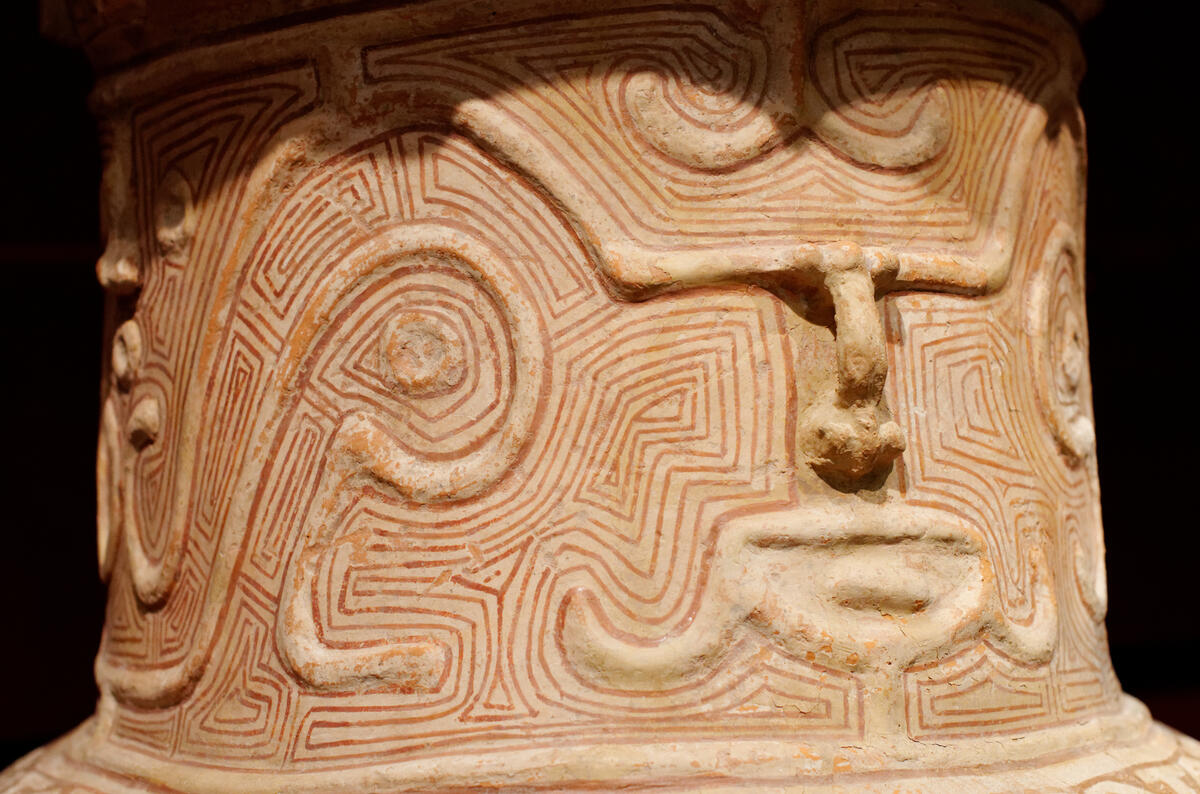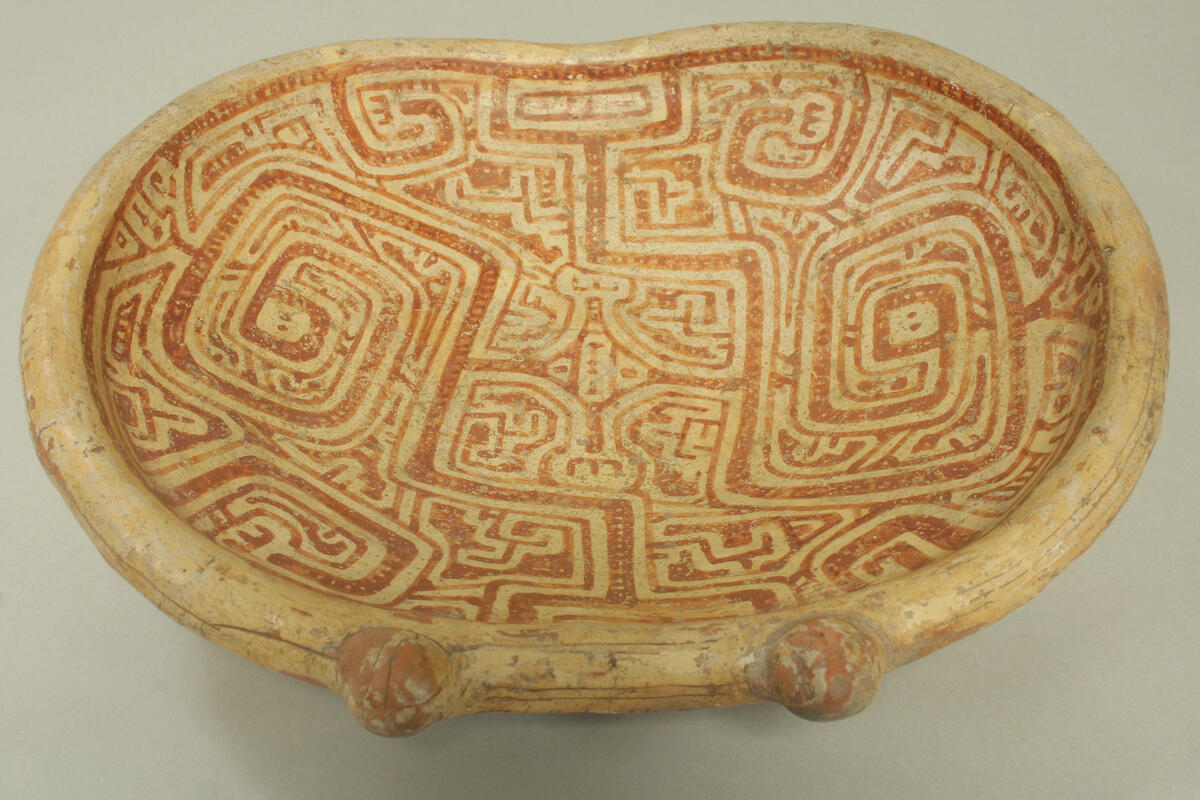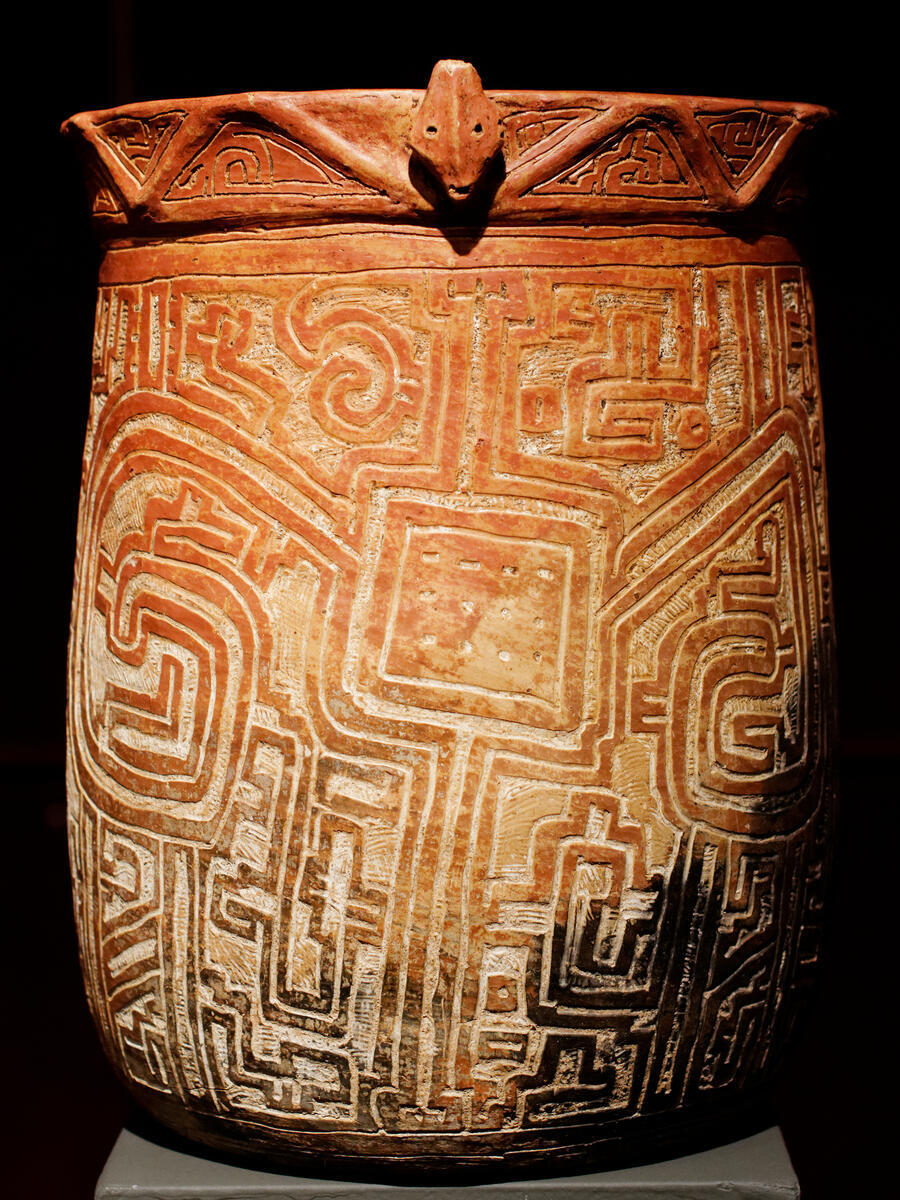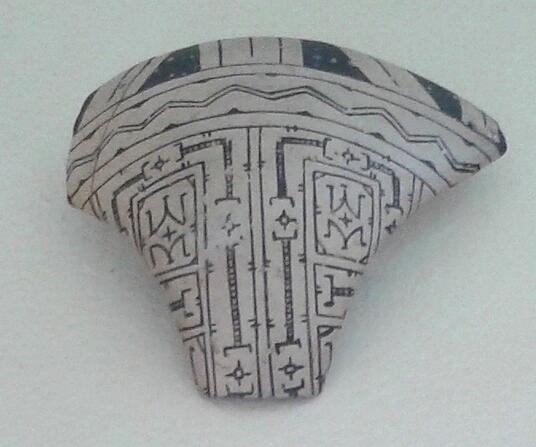
Face depicted on a large Marajoara urn
My name is Brian McCray, and I am an archaeologist who has worked on projects around the world. The first time I helped dig up an archaeological site I was so excited. What seemed like an ordinary patch of land in Virginia still held evidence of its previous inhabitants from hundreds of years earlier. In just a small one meter square area, we found changes in the color of the soil, a stone tool, and small pieces of broken pottery that had not been touched by a human for 200 years. Together, these objects showed us what people in the past made and valued. These fascinating finds made me appreciate how short my experience has been within the long span of human history. It also made me realize that the lives of ordinary people in the past can endure to be studied by future archaeologists.
What I love about archaeology is the way it brings us up close to the past in a material way. By excavating scientifically, archaeologists discover the many types of things people from the past left behind. Once archaeologists finish an excavation, they have a completely new set of information about humanity that does not rely on written records, which have only recorded a tiny fraction of human history.
In this kit, I’ve included information about one of the most interesting ancient South American societies. On a huge island in the mouth of the Amazon River, the Marajoara people invented new ways to manage floodwaters to support large populations based on aquatic resources like fish, plants, turtles, and other animals. By excavating the homes and places where the Marajoara lived, archaeologists have learned about their religion, society, and how they made a living in an environment that seems difficult to us today. I think it is important to learn about societies like Marajó because it helps us understand how past groups survived and thrived in challenging environments. Marajoara history contradicts the idea that certain locations, like tropical jungles, can only support tiny groups of people living in harmony with nature. Knowing how often past groups exceeded our expectations can help us face climate change today.
Sincerely,
Brian McCray
Marajó island is the size of the state of West Virginia, and located in the mouth of the Amazon River in Brazil, South America. Between CE 300 and 1350 , it was home to a group of people who built huge mounds to live on top of and perform religious ceremonies. The largest mounds, where parties and ceremonies took place, were more than three acres in area, that’s more than two football fields. This group included artists who made beautifully decorated pottery, religious leaders who led festivals and funerals, and political leaders who directed construction projects. Archaeologists often call societies where people can specialize in one job a complex society. They have been particularly interested in Marajó island because in the early 1900s, people thought the island’s climate made it impossible for a complex society to emerge there.
Water is the most important resource on the island. Every year, between January and June, most of the low-lying portions of the island (70%!) are flooded by rainfall. The floods bring fish and other water creatures right up on top of the island. The land animals of Marajó are forced onto the few higher elevation areas that stay dry. Then, during the dry season, from August to December, the rain stops, the water recedes, and many of the rivers dry up completely. The island is covered by forest in the Southwestern half, and open savanna in the northeast.
The people who lived on Marajó island, who we call the Marajoara, built mounds to stay safe and dry above the yearly floods. The entire island has not been examined by archaeologists, but an estimated 2000 people would have lived on one cluster of mounds. They built their houses, had religious ceremonies, and buried their ancestors on top of the mounds. They also built a system of fishponds and traps to catch fish during the rainy season and keep them alive and handy during the dry season. These fishponds were very large. One, along the Camutins river, was the size of eight Olympic swimming pools.
The island has no natural rock, but the Marajoara used clay to make their pottery and even some pieces of clothing! Their pots have complicated geometric designs, as well as pictures of wild animals that lived on and around the island. Caimans (a relative of the alligator that lives in central and South America), lizards, scorpions, owls, vultures, monkeys, turtles, jaguars, ducks, birds, and manatees all lived around Marajó. The most common animal in Marajoara art was the snake.

Marajoara plate. This plate has a painted geometric design that looks a little like the body of a snake, and also like the lines made by canals. A plate like this would have been used to serve food at an important ceremony. Image: Metropolitan Museum of Art / CC0
Based on how they chose to bury their dead, archaeologists believe that the Marajoara had permanent leaders, meaning some people were more powerful than others. These people lived on very large mounds, where they hosted feasts and religious rituals associated with the burials of their relatives in burial urns. The large mounds were frequently built near large fishponds, which would have given the powerful people control over food and ceremonies. One of the most common rituals was a coming-of-age ritual for young women. Also, many of the supernatural creatures depicted on pottery were women, and the richest burials were split between women and men. This led some archaeologists to suggest that women may have held the highest ranks in Marajoara society. While community leaders lived in special locations, most people lived on smaller mounds, only large enough for one house and probably one family.
For reasons still unknown, the Marajoara stopped building mounds between 1000 - 1350 CE, so we cannot rely on written sources to tell us about their history. By the 1800s, the Marajó mounds were known to looters, who dug up the beautiful pottery buried inside. The first scientific archaeological project on Marajó didn’t occur until 1942. The archaeologists, who were from the USA, thought that the Amazon jungle did not have enough sources of food to support large populations of people. They developed a theory that the builders of Marajó mounds were people who migrated from northern South America. In the Andes and the Caribbean, there were well known complex societies and fancy pottery where the environment was easier to live in. The first USA archaeologists suggested that Andean and Caribbean people moved to Marajó and used their knowledge to build mounds and make beautiful pottery. Once they were there, though, the scarce food made it difficult for them to maintain the specialization of artisans, religious leaders, and political leaders. These archaeologists believed that the lack of food led to a decline in quality of the pottery and mound structures. With these changes, people quickly abandoned the mounds.

Cylindrical Marajoara Vessel. The decoration on the body is incised, which means scraped away, to create a geometric design. On the rim, a raised zig-zag pattern forms the body of a snake with the head emerging at the center as a handle. This particular decoration is called Joanes - style, and it is found in the western part of the island.
Image: Marie-Lan Nguyen / CC-BY-2.5
This story of the Marajoara changed with the invention of new technology. When the early studies were carried out, the technology to collect accurate dates from archaeological materials was not developed yet. Later, archaeologists excavated on the island with the ability to gather accurate dates, and they found out three important things. First, the people before the Marajoara chiefdom also made art in styles related to the later pottery. This told them that the people who built the mounds were not immigrants from elsewhere. Second, the Marajoara pottery did not get worse in quality through time. There were simple and intricate examples throughout the assemblage. Third, the Marajoara period was much longer than previously thought. This means that the first archaeologists were wrong about how the environment would have prevented people in the Amazon from living in large populations, building large mounds, and producing artworks. The first group of archaeologists made important contributions to our knowledge of the Marajoara, but when more data was collected, the theory about the origin of the Marajoara changed.
Like the ancient Egyptians, who relied on the yearly flooding of the Nile River to water their crops, the people of Marajó knew how to take advantage of annual floods covering more than half of the island. They moved massive amounts of earth to create fields, mounds, ponds, roads, and dams. It makes sense to construct these things together. To make a raised field, you need to dig up soil, so why not make a canal at the same time? The raised fields had better soil for planting crops, and the canals next to them would drain away excess water, and even allow for canoe transport. The same process occurred with the mounds. Archaeologists found the largest ponds associated with the largest ceremonial mounds. This indicates that the soil removed from the human-made pond was used to build up the mound.
The rivers on Marajó all dry up completely in the dry season, and in the hot humid climate of Marajó island, it is difficult to preserve food for long. That is why the creation of fishponds was such an important innovation. The ponds would fill up when the island flooded, and the fish could be kept alive until they were needed for dinner, later in the dry season. This was a way of having easy access to fresh food long before refrigeration.
Another amazing find happened when archaeologists were able to track the soil dug out from a pool and used to raise a mound. They can still see thick layers of silt on the mounds that match excavations for the ponds and canals. One Brazilian archaeologist who has studied Marajó, Denise Schaan, observed that building episodes added layers to specific parts of the mounds, creating platforms at different heights. Unlike typical farmers, who live by the cycle of tilling, planting, and harvesting, the Marajoara lived by a cycle of digging canals and ponds, while also collecting fish and other aquatic resources. Because it is all about managing water and fish, Schaan refers to the food production as aquaculture, rather than the typical term for farming, agriculture.
The most famous artworks created by the Marajoara are called urns. These vessels originally contained the bones of the ancestors of the Marajoara people. The urns were found buried inside the largest mounds. Because they are associated with the dead, archaeologists call these ceremonial mounds. The funerals of the Marajoara involved a type of practice called secondary burial. A secondary burial is a two-part process. First, the body of a dead relative was cremated, buried, or put in a tomb. Later, after a period of mourning, the bones were collected and placed in a large urn. This indicates that honoring ancestors was important in Marajoara society. Cremation is a common secondary burial practice today, too. Many people choose to be cremated when they die, then their families keep the ashes of their loved ones in urns.

Face depicted on an urn. This ceramic urn is almost 3 feet tall and 2 feet wide! The raised designs have snake features, and the body of the urn is painted with an owl design.
Image: Marie-Lan Nguyen / CC-BY-2.5
Marajoara religious art may tell us something about their beliefs regarding gender, too. Interpreting ideas related to gender in past societies is challenging, especially without written documents. But luckily, archaeologists can interpret certain beliefs from art. Marajoara art frequently depicts people or supernatural beings with female characteristics (see the anthropomorphic urn in the next section, for example). Often, female characteristics are combined with animal features, like snakes, owls, vultures, or caimans. There is a certain type of pottery, called a tanga, that was part of the clothing worn by girls participating in a coming-of-age ceremony. This ceremony continued into the 1900s, and evidence for the same kind of pottery is very common at Marajoara mounds. Together, this is evidence for the importance of women in Marajoara society. Some archaeologists believe the art represents a Great Mother goddess, and that the chiefs of Marajó may have been women. After all, the Amazon River was named because early travelers described powerful native women who reminded them of the mythical Amazon warriors.

Tanga. This ceramic would have been attached to clothing worn by women during a coming-of-age ceremony. It is shaped and curved so that it can be worn similar to underwear. The designs likely helped identify different families or social groups.
When archaeologists say that Marajoara society was a complex society, they mean that there was a permanent political leader who had power over others. The base for the complex societies that arose in the Marajoara period was laid thousands of years earlier when people on the island first learned to build mounds in the savanna, an open area covered in long grass. Eventually, the abundance of water resources led to population growth. The successful aquaculture systems then spread to similar locations around the island. The pattern of living and creating art spread to cover most of the open savanna on the island.
Judging by the amount of space on top of the mounds, we can estimate the size of houses in which families lived. Marajoara families lived in longhouses. We can compare them with people who live in longhouses in the Amazon, today. Judging by the size and number of mounds, 2,000 people likely lived just along one section of the Camutins river in the center of the island. (See the map above. This region is identified by a gray shape).
Remember, the first archaeologists believed that the Marajoara must have come from somewhere else. Many people thought that native Amazonian people always lived in small mobile groups. It was true of the remaining uncontacted native groups at the time. The native groups living in the Amazon jungle in the 1800s did not farm very much or stay in villages for more than a few years. What people are now realizing is that these groups were not moving because the Amazon required it. They were moving to avoid the Portuguese and Brazilian settlers. The Marajoara mounds and pottery show that despite environmental difficulties, 1600 years ago a much different way of life emerged.

This urn is shaped in the form of a seated woman. She has designs painted on her skin and is in the act of eating. This might reflect the way the Marajoara would hold feasts to honor their ancestors. This urn is too small to hold a human body. Instead, it would have been used for a secondary burial.
Image: Daderot / CC0
